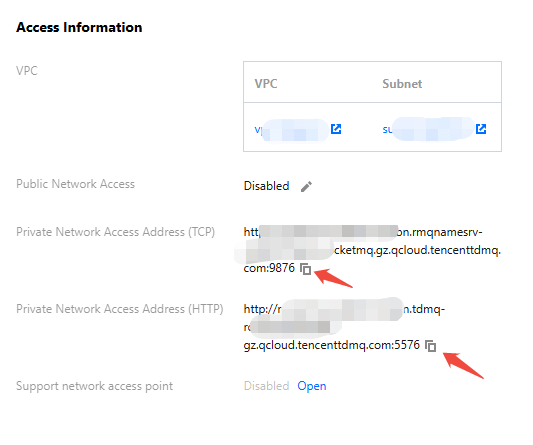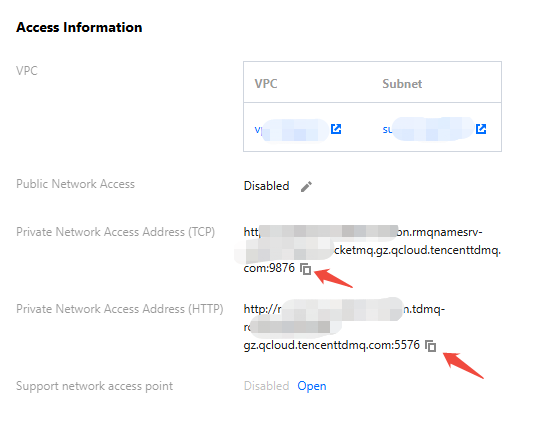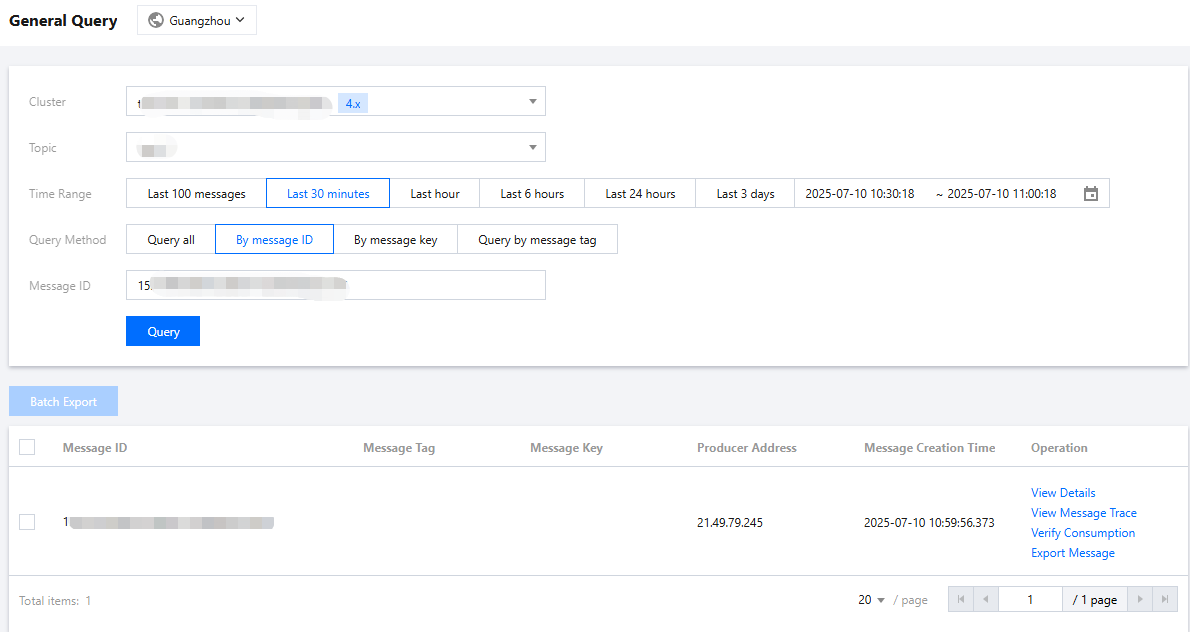SDK for Go
最終更新日:2025-07-15 18:32:08
Overview
This document describes how to use open-source SDK to send and receive messages by using the SDK for Go as an example and helps you better understand the message sending and receiving processes.
Prerequisites
You have created the required resources as instructed in Resource Creation and Preparation.
You have installed Go.
Directions
1. Run the following command in the client environment to RocketMQ client dependencies.
go get github.com/apache/rocketmq-client-go/v2
2. Create a producer in the corresponding method. If you need to send general messages, modify the corresponding parameters in the
syncSendMessage.go file.Delayed messages currently support delays of arbitrary precision without being subject to the delay level.
// Service access address (Note: Add “http://” or “https://” before the access address; otherwise, it cannot be resolved)var serverAddress = "https://rocketmq-xxx.rocketmq.ap-bj.public.tencenttdmq.com:9876"// Authorize the role namevar secretKey = "admin"// Authorize the role tokenvar accessKey = "eyJrZXlJZC...."// Full namespace namevar nameSpace = "MQ_INST_rocketmqem4xxxx"// Producer group namevar groupName = "group1"// Create a message producerp, _ := rocketmq.NewProducer(// Set the service addressproducer.WithNsResolver(primitive.NewPassthroughResolver([]string{serverAddress})),// Set ACL permissionsproducer.WithCredentials(primitive.Credentials{SecretKey: secretKey,AccessKey: accessKey,}),// Set the producer groupproducer.WithGroupName(groupName),// Set the namespace nameproducer.WithNamespace(nameSpace),// Set the number of retries upon sending failuresproducer.WithRetry(2),)// Start the producererr := p.Start()if err != nil {fmt.Printf("start producer error: %s", err.Error())os.Exit(1)}
// Topic namevar topicName = "topic1"// Producer group namevar groupName = "group1"// Create a message producerp, _ := rocketmq.NewProducer(// Set the service addressproducer.WithNsResolver(primitive.NewPassthroughResolver([]string{"https://rocketmq-xxx.rocketmq.ap-bj.public.tencenttdmq.com:9876"})),// Set ACL permissionsproducer.WithCredentials(primitive.Credentials{SecretKey: "admin",AccessKey: "eyJrZXlJZC......",}),// Set the producer groupproducer.WithGroupName(groupName),// Set the namespace nameproducer.WithNamespace("rocketmq-xxx|namespace_go"),// Set the number of retries upon sending failuresproducer.WithRetry(2),)// Start the producererr := p.Start()if err != nil {fmt.Printf("start producer error: %s", err.Error())os.Exit(1)}for i := 0; i < 1; i++ {msg := primitive.NewMessage(topicName, []byte("Hello RocketMQ Go Client! This is a delay message."))// Set delay level// The relationship between the delay level and the delay time:// 1s, 5s, 10s, 30s, 1m, 2m, 3m, 4m, 5m, 6m, 7m, 8m, 9m, 10m, 20m, 30m, 1h, 2h;// 1 2 3 4 5 6 7 8 9 10 11 12 13 14 15 16 17 18// If you want to use the delay level, then set the following method:msg.WithDelayTimeLevel(3)// If you want to use any delayed message, then set the following method without setting `WithDelayTimeLevel`. The unit is milliseconds. The following shows that a delayed message is delivered after 10 seconds.delayMills := int64(10 * 1000)msg.WithProperty("__STARTDELIVERTIME", strconv.FormatInt(time.Now().Unix()+delayMills, 10))// Send the messageres, err := p.SendSync(context.Background(), msg)if err != nil {fmt.Printf("send message error: %s\\n", err)} else {fmt.Printf("send message success: result=%s\\n", res.String())}}// Release resourceserr = p.Shutdown()if err != nil {fmt.Printf("shutdown producer error: %s", err.Error())}
Note:
Parameter | Description |
secretKey | Role name, copy from the SecretKey column on the Role Management page in the console. |
accessKey | Role token, copy from the AccessKey column on the Role Management page in the console.  |
nameSpace | Namespace name, which can be copied on the Namespace page in the console.  |
serverAddress | Obtain the cluster access address from the access information module on the console cluster basic information page. (Note: add http:// or https:// before the access address, otherwise it cannot be parsed).  |
groupName | Copy the producer group name from the Group Management page on the console.  |
3. The process of sending messages (using sync sending as an example) is the same as above.
// Topic namevar topicName = "topic1"// Configure message contentmsg := &primitive.Message{Topic: topicName, // Set the topic nameBody: []byte("Hello RocketMQ Go Client! This is a new message."),}// Set tagsmsg.WithTag("TAG")// Set keysmsg.WithKeys([]string{"yourKey"})// Send the messageres, err := p.SendSync(context.Background(), msg)if err != nil {fmt.Printf("send message error: %s\\n", err)} else {fmt.Printf("send message success: result=%s\\n", res.String())}
Parameter | Description |
topicName | Topic name, which can be copied under the Topic tab on the cluster details page in the console.  |
TAG | Message tag identifier |
yourKey | Message business key |
Release the resource.
// Disable the producererr = p.Shutdown()if err != nil {fmt.Printf("shutdown producer error: %s", err.Error())}
Note:
4. Create a consumer.
// Service access address (Note: Add “http://” or “https://” before the access address; otherwise, it cannot be resolved)var serverAddress = "https://rocketmq-xxx.rocketmq.ap-bj.public.tencenttdmq.com:9876"// Authorize the role namevar secretKey = "admin"// Authorize the role tokenvar accessKey = "eyJrZXlJZC...."// Full namespace namevar nameSpace = "rocketmq-xxx|namespace_go"// Producer group namevar groupName = "group11"// Create a consumerc, err := rocketmq.NewPushConsumer(// Set the consumer groupconsumer.WithGroupName(groupName),// Set the service addressconsumer.WithNsResolver(primitive.NewPassthroughResolver([]string{serverAddress})),// Set ACL permissionsconsumer.WithCredentials(primitive.Credentials{SecretKey: secretKey,AccessKey: accessKey,}),// Set the namespace nameconsumer.WithNamespace(nameSpace),// Set consumption from the start offsetconsumer.WithConsumeFromWhere(consumer.ConsumeFromFirstOffset),// Set the consumption mode (cluster consumption by default)consumer.WithConsumerModel(consumer.Clustering),//For broadcasting consumption, set the instance name to the system name of the application. If the instance name is not set, the pid will be used, which will cause a restart for repeated consumptionconsumer.WithInstance("xxxx"),)if err != nil {fmt.Println("init consumer2 error: " + err.Error())os.Exit(0)}
Note:
Parameter | Description |
secretKey | Role name, copy from the SecretKey column on the Role Management page in the console. |
accessKey | Role token, copy from the AccessKey column on the Role Management page in the console.  |
nameSpace | Copy the namespace name from the Namespace page in the console. If you use a 4.x generic cluster or 5.x cluster, fill in the Cluster ID here.  |
serverAddress | Obtain the cluster access address from the access information module on the console cluster basic information page. (Note: add http:// or https:// before the access address, otherwise it cannot be parsed).  |
groupName | Copy the producer group name from the Group Management page on the console.  |
5. Consume a message.
// Topic namevar topicName = "topic1"// Set the tag of messages that are subscribed toselector := consumer.MessageSelector{Type: consumer.TAG,Expression: "TagA || TagC",}// Set the delay level of consumption retry. A total of 18 levels can be set. Below is the relationship between each delay level and the delay time.// 1 2 3 4 5 6 7 8 9 10 11 12 13 14 15 16 17 18// 1s, 5s, 10s, 30s, 1m, 2m, 3m, 4m, 5m, 6m, 7m, 8m, 9m, 10m, 20m, 30m, 1h, 2hdelayLevel := 1err = c.Subscribe(topicName, selector, func(ctx context.Context,msgs ...*primitive.MessageExt) (consumer.ConsumeResult, error) {fmt.Printf("subscribe callback len: %d \\n", len(msgs))// Set the delay level for the next consumptionconcurrentCtx, _ := primitive.GetConcurrentlyCtx(ctx)concurrentCtx.DelayLevelWhenNextConsume = delayLevel // only run when return consumer.ConsumeRetryLaterfor _, msg := range msgs {// Simulate a successful consumption after three retriesif msg.ReconsumeTimes > 3 {fmt.Printf("msg ReconsumeTimes > 3. msg: %v", msg)return consumer.ConsumeSuccess, nil} else {fmt.Printf("subscribe callback: %v \\n", msg)}}// Simulate a consumption failure. Retry is required.return consumer.ConsumeRetryLater, nil})if err != nil {fmt.Println(err.Error())}
Parameter | Description |
topicName | Topic name, which can be copied on the Topic page in the console. |
Expression | Message tag identifier |
delayLevel | A parameter used to set the delay level of consumption retry. A total of 18 delay levels are supported. |
6. Consume messages (the consumer can consume messages only after the messages are subscribed to).
// Start consumptionerr = c.Start()if err != nil {fmt.Println(err.Error())os.Exit(-1)}time.Sleep(time.Hour)// Release resourceserr = c.Shutdown()if err != nil {fmt.Printf("shundown Consumer error: %s", err.Error())}
7. View consumption details. After sending the completion message, you will get a message ID (messageID). You can query the just-sent message on the console in Message Query, as well as the message details and path information.

Note
Above is a brief introduction to how to send and receive messages with the Go client. For more information, see Demo or Rocketmq-Client-Go Example.
フィードバック
